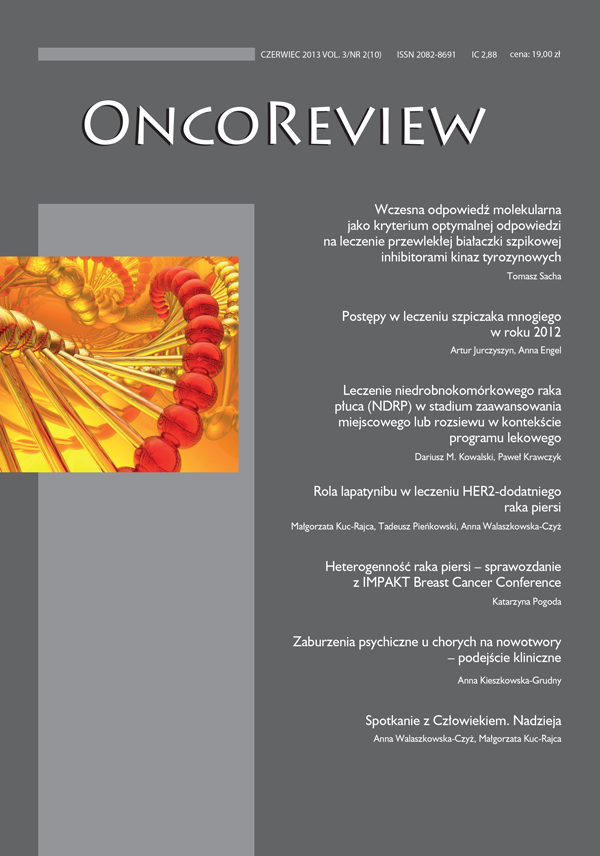Progress in treatment of multiple myeloma in year 2012 Review article
Main Article Content
Abstract
Multiple myeloma (MM) is still considered as incurable proliferative disease. In 2012 almost 100 articles were published showing progress in the treatment of this disease. The importance of further research on cereblon was reported. Cereblon is protein which sensitivity to the immunomodulatory drugs determines the effectiveness of treatment. In the United States of America two new drugs were approved for treatment of MM: carfilzomib and pomalidomide. They exhibit fewer side effects and longer survival rate than the first generation drugs. In the United States were registered as drugs of second and third lines of treatment in patients with refractory or progressed MM.
Downloads
Metrics
Article Details

This work is licensed under a Creative Commons Attribution-NonCommercial 4.0 International License.
Copyright: © Medical Education sp. z o.o. This is an Open Access article distributed under the terms of the Attribution-NonCommercial 4.0 International (CC BY-NC 4.0). License (https://creativecommons.org/licenses/by-nc/4.0/), allowing third parties to copy and redistribute the material in any medium or format and to remix, transform, and build upon the material, provided the original work is properly cited and states its license.
Address reprint requests to: Medical Education, Marcin Kuźma (marcin.kuzma@mededu.pl)
References
2. Kuhn D.J., Chen Q., Voorhees P.M. et al.: Potent activity of carfilzomib, a novel, irreversible inhibitor of the ubiquitin-proteasome pathway, against preclinical models of multiple myeloma. Blood 2007; 110(9): 3281-3290.
3. Jakubowiak A., Dytfeld D., Griffith K.A. et al.: A phase 1/2 study of carfilzomib in combination with lenalidomide and low-dose dexamethasone as a frontline treatment for multiple myeloma. Blood 2012; 120(9): 1801-1809.
4. Leleu X., Attal M., Arnulf B. et al.: Pomalidomide plus low-dose dexamethasone is active and well tolerated in bortezomib and lenalidomide-refractory multiple myeloma: Intergroupe Francophone du Myelome 2009-02. Blood 2013; 121(11): 1968-1975.
5. Chustecka Z., Mulcahy N.: FDA approved pomalidomide for multiple myeloma. Online: http://www.medscape.com/viewarticle/779048_print.
6. Andhavarapu S., Roy V.: Immunomodulatory drugs in multiple myeloma. Expert Rev. Hematol. 2013; 6(1): 69-82.
7. Fermand J.P., Ravaud P., Chevret S. et al.: High-dose therapy and autologous peripheral blood stem cell transplantation in multiple myeloma: up-front or rescue treatment? Results of a multicentre sequential randomized clinical trial. Blood 1998; 92(9): 3131-3136.
8. Kumar S.K., Lacy M.Q., Diapenzieri A. et al.: Early versus delayed autologous transplantation after immunomodulatory agents-based induction therapy in patients with newly diagnosed multiple myeloma. Cancer 2012; 118(6): 1585-1592.
9. Jurczyszyn A., Skotnicki A.B.: Zasady leczenia szpiczaka mnogiego w oparciu o zalecenia Polskiej Grupy Szpiczakowej na rok 2011. W: Szpiczak mnogi, wybrane zagadnienia. Tom II. Wyd. I. Fundacja Centrum Leczenia Szpiczaka, Kraków 2011.
10. Rajkumar S.V.: Understanding prognosis in multiple myeloma. Online: http://www.myelomabeacon.com/news/2012/03/01/understanding-prognosis-in-multiple-myeloma/.

